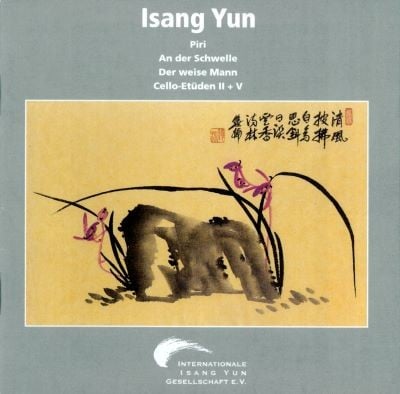Bote & Bock
The Seven Etudes for solo cello (1993) dedicated to the cellist Walter Grimmer are progressive studies in playing technique and compositional technique. Their dramaturgy geared toward intensification and increase is comparable to a number of similarly styled cycles by Isang Yun: each piece forms a cosmos of its own; at the same time, the seven movements composed in mutual contrast form an organic whole. Its constitutive interval is the upward oriented sixth. The etudes in each case treat specific problems of playing technique while also forming a compendium of Isang Yun’s compositional technique. Yun, who died in 1995, no longer had the opportunity to compose second and third volumes. Beyond the accomplishing of tasks in the area of playing technique, what is involved in each case is — here fundamental — questions of expression, the suggestive sound ideal of a spacious performance style aiming at freedom and liberation.
In order to demarcate the individual pieces of the cycle, Yun even varies the metrical types: I. Legato (5/4 time), II. Leggiero (4/4), III. Parlando (6/4), IV. Burlesque (3/4), V. Dolce (6/4), VI. Triller [Trills] (4/4), VII. Doppelgriffe [Double Stops] (5/4). In contrast to the predominately twelve-tone idiom of the Glissées, the four etudes for solo cello from 1970, in the Seven Etudes Yun expounds with a few central tones (such as c sharp and a) and the chromatic tones in their immediate vicinity (such as c or d and g sharp or b flat) seemingly simplified relations. In these he forms a playful-popular performance style on the basis of more concrete shapes and characters.
The first etude is of refined simplicity. Its specific tone — according to Yun, the expression of the Legato is "quiet and elegant" — emerges from the developing variation of the two-tone motivic cells (initially c sharp – a) pointing the final sound. Even the note lengths are reduced to the musical elementary, to quarters or eighths on the one hand and to long-drawn-out notes on the other hand. As a result, an asymmetrical periodicity is produced in the "bumpy" 5/4 time correspondences of rhythmic, syntactic, and melodic nature are heard. The "twilight zone" of tonal states of suspension is generally characteristic of the chamber music of the late Yun (from 1984): with the principles of the developing variation and gliding over the semitone, he here organizes a seeming a minor or even A major tonality (with the subdominant D or d toward the middle); but what is important, however, are not the tonal relations but the intervalic ones, the "distances" between the tones and motifs.
If the Legato etude involves sparing and concentrated bowing, then the Leggiero etude is dedicated to the study of the pressure applied by the bow, which always has to be led lightly and flexibly. The Leggiero character — it is supposed to to sound "like a gentle breeze" (Yun) — is now developed from d. Yun develops motif chains of increasing length from the clearly rhythmized initial model. The sound process of upward orientation twice reaches a high tone heard a number of times, like a ball bouncing against an obstacle. Here Yun seems to be making a humorous allusion to Antonín Dvorák’s Cello Concerto. At the end Yun includes Legato gestures from the first etude.
The Parlando etude involves speaking articulation and swiftly alternating articulation types. The fact that Yun wanted the Parlando to be executed as a "whispering conversation" demonstrates the relative nature of his dynamic markings: the instrumentalist is supposed to realize the fortissimo notated a number of times in this etude on the basis of the idea of intensive whispering. Here, too, Yun does not rigidly adhere to a single character but anticipatingly draws on Doppelgriffe and Triller. He varies and relativizes the ironically cadencing conclusion (dominant – tonic in D major) of this third etude with the beginning of the dancy fourth etude. The Burlesque, a rhythm study, begins with the double stops A major – b minor; in 3/4 time it is initially the second beat that is emphasized.
The fifth etude, Dolce (sempre con sordino, "love and personal feelings"), is not only a meditative piece of music but also a finely nuanced study of quiet dynamic gradations. First the "exterritorial" sixth g – e flat is heard, and it is gradually transformed into a harmony related to the central tone c sharp. After a phase of relatively static circling a gradually upward tendency toward the highest tone (g1 sharp) of the piece begins, with this tendency being followed by the successive return.
Yun initially thematizes the Triller of the sixth etude on two pitch levels and then even ends up expanding their distances. The juxtaposition and mediation of the low and high sounds is again clearly stated compositionally in the concluding Doppelgriffe etude. This is also to be interpreted symbolically as an expression of earthly captivity and the yearning for heavenly purity.
If Yun’s technique of permanent variation is thoroughly anchored in the European tradition, then his expression is always "his own" and new because the continuous dynamization of each single tone and the flowing Korean character of his personal style in large part form an overlay, superimposed on the underlay of the relation to traditional models and modifying it significantly. Here he also holds humorous formulations and surprising turns in store.
Walter-Wolfgang Sparrer (translated by Susan Marie Praeder), 2005

Myung-Jin Lee (Etudes No.2 & 5)
Internationale Isang Yun Gesellschaft IYG 004
